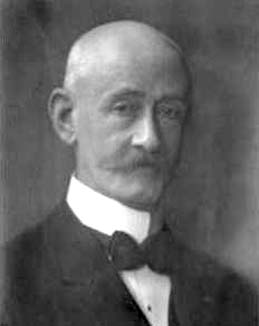
Hendrik de Vries
 المؤلف:
H Pijls
المؤلف:
H Pijls
 المصدر:
Hendrik de Vries (1867-1954), The Biographical Dictionary of Dutch Mathematicians
المصدر:
Hendrik de Vries (1867-1954), The Biographical Dictionary of Dutch Mathematicians
 الجزء والصفحة:
...
الجزء والصفحة:
...
 4-4-2017
4-4-2017
 568
568
Born: 25 August 1867 in Amsterdam, The Netherlands
Died: 3 March 1954 in Binyamina, Israel

Hendrik de Vries sometimes has his first name with the spelling Hendrick. Hendrik's father was David de Vries who, at the time of his son's birth, was a schoolteacher at the ambachtsschool in Amsterdam. The ambachtsschool was the name of a type of school set up in the Netherlands in 1865 to train pupils for careers in industry, providing education for those who previously after leaving primary school had virtually no opportunity to further education. When Hendrik was still very young, his father was appointed as the headmaster of a ambachtsschool in Rotterdam and the family moved to that city where Hendrik was brought up.
Most of de Vries's school education was in Rotterdam but, in 1884, when he was seventeen years old, the family moved again, this time to Frauenfeld in Switzerland. He completed his secondary education in Frauenfeld, then entered the Eidgenossische Polytechnicum in Zurich in 1886. After four years of study, de Vries graduated from the Eidgenossische Polytechnicum in 1890 and was appointed as an assistant to D Fiedler, who had taught him as an undergraduate, to work on descriptive and projective geometry. In 1894, after four years as Fiedler's assistant, de Vries returned to the Netherlands. He became a teacher at the first five-year secondary school (hogere burgerschool) in Amsterdam. At the same time he studied for a doctorate in mathematics at the University of Amsterdam with Diederik Korteweg as his supervisor. He was awarded a doctorate in 1901 having submitted his thesis Over de restdoorsnede van twee volgens eene vlakke kromme perspectivische kegels, en over satelliet krommen.
In 1902 de Vries was appointed as a mathematics teacher at the Polytechnic School in Delft. In 1905 the school was transformed into a Technical High School and de Vries remained there for one further year before his appointment as a Professor of Mathematics at the Municipal University of Amsterdam in 1906. He held this position until he retired in 1937. At Amsterdam, he supervised the doctoral studies of a number of students who went on the make important contributions to mathematics, the most famous of these being Bartel van der Waerden who was awarded a doctorate in 1926 for a thesis on the foundations of algebraic geometry. Although initially de Vries' interest involved research in geometry, and in particular projective geometry, he became interested in the history of mathematics through reading the works of Monge, Plücker and Möbius.
In [1] Paul Bockstable describes de Vries's contributions:-
Even greater emphasis was placed on the historical development of mathematical sciences in the historical writings of Hendrik de Vries (1867-1954), professor at the Municipal University of Amsterdam. His lectures took in algebra and analysis, but from 1921-22 onwards, he focussed increasingly on his preferred field, giving public lectures on the development of geometry. These culminated in a series of articles in the Nieuw Tijdschrift voor Wiskunde (New Journal of Mathematics), which were later collected, together with some other items, in a three volume publication entitled 'Historische Studien'(1926). De Vries wrote in the introduction that he wanted to focus attention on the historical development of very precisely defined topics, even specific problems or theorems. He pointed out the didactic benefits that the historical approach to mathematical problems could offer.
He continued to publish Historical studies, and as examples we give the title of a small number of these later articles: On the contact and intersection of circles and conic sections (1946), How analytic geometry became a science (1948), On the infinite and the imaginary, or "surrealism" in mathematics (1949), and On relations and transformations (1949).
Hendrik de Vries was married and had two children.
Articles:
- P Bockstable, Benelux, in Joseph W. Dauben, Christoph J. Scriba (eds.), Writing the history of mathematics: its historical development (Birkhäuser, 2002).
- H Pijls, Hendrik de Vries (1867-1954), The Biographical Dictionary of Dutch Mathematicians
http://www.bwnw.nl/index.html
- B L van der Waerden, Levensbericht van Hendrik de Vries, Levensberichten van de Koninklijke Nederlandse Academie van Wetenschappen (1953-1954), 275-277.
 الاكثر قراءة في 1865to1869
الاكثر قراءة في 1865to1869
 اخر الاخبار
اخر الاخبار
اخبار العتبة العباسية المقدسة


